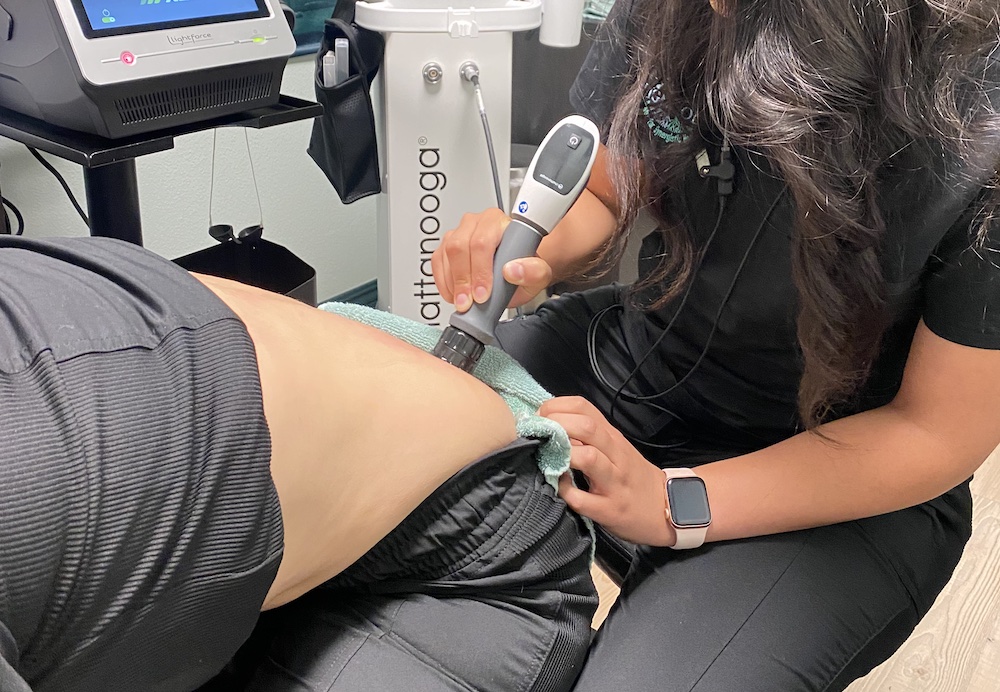As a local chiropractor, I often get asked how adjustments can improve your flexibility. It's a great question! When we perform adjustments, we focus on relieving muscle tension and correcting imbalances in your body. This not only helps with better alignment but also allows for a greater range of motion in your joints.
Through techniques like manual therapy, we stimulate circulation and alleviate tightness, which can significantly enhance your ability to move freely. But the benefits of chiropractic care extend beyond just physical performance. You'll also find that these adjustments help create a stronger mind-body connection, promoting overall well-being.
So, what actually happens in your body during an adjustment? And how can you seamlessly incorporate these practices into your daily routine to maximize their benefits? Let's explore these questions together and help you achieve your health goals!
Understanding Flexibility
Flexibility isn't just about how well you can touch your toes; it's a crucial aspect of your overall health and wellness that can significantly influence how you tackle life's challenges. As your chiropractor, I want to help you understand that flexibility goes beyond physical stretching—it's also a mindset that can enhance your approach to both personal and professional situations.
When you think about flexibility, it's common to focus solely on physical abilities. However, true flexibility requires you to adapt your thoughts, behaviors, and strategies as circumstances change. This adaptability is essential not only for your physical health but also for your mental well-being.
To foster this flexible mindset, begin by reflecting on your current thoughts and beliefs. Are you holding onto rigid ideas about health and healing? If so, I encourage you to explore new perspectives. Embracing the unknown and being open to different approaches can feel uncomfortable, but it's a vital part of your journey toward growth and healing.
Instead of viewing health challenges as setbacks, try to see them as opportunities for learning and improvement. This shift in perspective can empower you to manage your health more effectively.
In our practice, we emphasize the importance of communication and collaboration. By actively listening to your body and engaging with your healthcare team, you'll gain valuable insights that can enhance your adaptability. Being open to feedback from your chiropractor and understanding the adjustments we recommend will allow you to find new ways to support your health.
It's also important to remember that flexibility doesn't mean compromising your core values or health goals. Rather, it's about striking a balance between your principles and the necessity of adapting to new circumstances.
As you cultivate this mindset, you may find that flexibility leads to greater innovation and creativity in your approach to health and wellness. So, I invite you to take that first step today—challenge yourself to embrace adaptability, and watch how it transforms your experience with your health and life's various challenges.
Types of Adjustments
As a local chiropractor, I want to help you understand the different types of adjustments that can significantly improve your health and well-being.
These adjustments come in various forms, each designed to target specific areas of your body, enhancing your flexibility and overall health. Let's take a look at some key types you should be aware of.
First, we've static adjustments. These involve holding a position for a longer duration, allowing your muscles and joints to relax and elongate.
Static stretching is something many of us already do, whether it's reaching for our toes or holding a specific yoga pose. It's essential for promoting relaxation and flexibility.
Next are dynamic adjustments. These adjustments incorporate movement, using gentle and controlled motions that mimic the activities you engage in daily.
Think of dynamic stretches like arm circles or leg swings. These are excellent for warming up your muscles and enhancing flexibility, preparing your body for physical activity.
Another important type is proprioceptive neuromuscular facilitation (PNF). This technique combines stretching and contracting of the targeted muscle group.
Often, it's helpful to work with a partner for PNF, as they can assist you in achieving deeper stretches, ultimately leading to improved flexibility.
Lastly, we've myofascial release. This technique focuses on relieving tension in the fascia, the connective tissue that surrounds our muscles.
By applying gentle pressure to specific areas, we can alleviate tightness and enhance your range of motion, which is crucial for overall mobility.
By understanding these different types of adjustments, you can take a proactive approach to your health and well-being.
If you have any questions or want to learn more about how these adjustments can benefit you, don't hesitate to reach out.
Your journey to better health starts with knowledge and care!
Role of Manual Therapy
As a local chiropractor, I want to take a moment to shed light on the vital role that manual therapy plays in enhancing your flexibility and promoting overall well-being. Many individuals may not be aware of how effective techniques like chiropractic adjustments, massage, and manipulation can be in providing immediate relief from tension and discomfort.
When you come in for a session, I focus on specific areas of tightness or restriction in your body. By doing so, we work together to restore balance and alignment, not only alleviating pain but also increasing your range of motion. This targeted approach can significantly improve how you move and feel.
One of the benefits you'll notice during manual therapy is enhanced circulation. This increased blood flow delivers essential nutrients to your muscles and tissues, helping to reduce inflammation and facilitating quicker recovery from physical activities.
Furthermore, manual therapy can effectively break down adhesions and scar tissue that may limit your movement, allowing you to enjoy a greater freedom of motion.
As we continue with your manual therapy sessions, you may also become more aware of how your body responds to different techniques. This heightened body awareness is crucial for learning how to engage and relax specific muscles, ultimately helping you prevent injuries and improve your flexibility.
Incorporating manual therapy into your wellness routine can be a fantastic complement to your regular exercise regimen. It prepares your body for movement and supports your recovery afterward.
Stretching Techniques Explained
As a chiropractor, I want to emphasize the importance of flexibility in maintaining a healthy body. While manual therapy is a great starting point for enhancing your flexibility, incorporating effective stretching techniques into your routine is essential for maximizing your range of motion.
Stretching not only helps to elongate your muscles but also prepares your body for movement, which can significantly reduce the risk of injury. Here are three important stretching techniques I recommend:
- Static Stretching: This technique involves holding a stretch for a specific duration, typically between 15 to 60 seconds. It's most beneficial when performed after your workouts, as your muscles are warm and more receptive to stretching. For example, you can try the hamstring stretch by sitting with one leg extended and reaching toward your toes to feel a gentle pull in the back of your leg.
- Dynamic Stretching: Unlike static stretching, dynamic stretching involves controlled movements that take your body through its full range of motion. I encourage you to incorporate movements like leg swings, arm circles, or walking lunges into your warm-up routine. This not only increases blood flow but also enhances flexibility before you engage in more intense activities.
- PNF Stretching (Proprioceptive Neuromuscular Facilitation): This advanced technique is particularly effective for improving flexibility. It combines both stretching and contracting the muscle group. To practice PNF stretching, begin by stretching your muscle, then apply resistance while contracting it for a few seconds before relaxing and stretching even deeper. Working with a partner or a trainer can enhance this technique, making it more effective.
Incorporating these stretching techniques into your routine can greatly benefit your overall health and well-being.
If you have any questions or need guidance on how to implement these stretches safely, feel free to reach out during your next visit!
Benefits of Improved Mobility
As a local chiropractor, I want to share how improved mobility can significantly enhance your daily life and overall well-being. When you achieve better mobility, everyday activities become much simpler and more enjoyable. Tasks such as bending down to tie your shoes or reaching for items on a high shelf can become effortless.
You'll likely notice an increase in your activity levels and engagement, whether you're playing with your children, exercising, or even just running errands.
One of the key benefits of enhanced mobility is its role in injury prevention. With greater flexibility and a wider range of motion, your body is better equipped to handle various movements without putting undue strain on your muscles and joints. This means that you can reduce the risk of injuries not only during workouts but also during routine activities.
Improved mobility also translates to better physical performance. Whether you're an athlete or someone who enjoys occasional workouts, increased flexibility allows you to achieve better form and efficiency. You'll notice that your exercise sessions become more productive, helping you reach your fitness goals more quickly and effectively.
Beyond the physical advantages, there's a significant mental component to improved mobility. The ability to move freely often enhances your mood and mindset, leading to reduced stress and an overall sense of well-being. As you gain confidence in your physical abilities, you may find yourself more willing to take on challenges that once felt daunting.
Additionally, greater mobility can enrich your social life. When you feel more mobile, you're more likely to engage in activities with friends and family, whether it's hiking, dancing, or simply enjoying a day out.
The Science of Muscle Tension
As a local chiropractor, I want to help you understand the importance of muscle tension for maintaining mobility and preventing injuries. Muscle tension is essentially the state of contraction in your muscles, and it plays a crucial role in how they operate. When you engage in physical activities, your muscles contract to facilitate movement. However, excessive tension can lead to stiffness, discomfort, and even injuries.
Let's explore three key concepts that highlight the significance of muscle tension:
- Ideal Tension: It's vital for your muscles to maintain an ideal level of tension. If there's too little tension, your movements may be weak and unstable. Conversely, excessive tension can lead to tightness and restrict your flexibility. Finding the right balance is essential for effective movement and overall physical health.
- Stretching and Relaxation: Understanding how stretching influences muscle tension can greatly enhance your flexibility. When you stretch, you're effectively signaling your muscles to relax, which allows for a greater range of motion. This process not only helps reduce unnecessary tension but also promotes better muscle function, which is key in chiropractic care.
- Mind-Muscle Connection: Developing a strong connection between your mind and muscles can greatly aid in controlling muscle tension. By becoming aware of how your muscles feel during movements, you can adjust the tension levels as needed. This heightened awareness can lead to improved performance in your daily activities and a reduced risk of injury.
At our chiropractic office, we focus on helping you achieve this balance in muscle tension through personalized care and natural healing methods.
Understanding and managing muscle tension is a fundamental part of your journey to better health and well-being.
Exercise Routines for Flexibility
As a chiropractor dedicated to your overall well-being, I want to emphasize the importance of flexibility in maintaining a healthy body. Incorporating specific exercise routines into your daily regimen is essential for enhancing flexibility, which plays a crucial role in improving your range of motion and preventing injuries.
To begin, I recommend starting with dynamic stretches such as arm circles and leg swings. These movements are excellent for warming up your muscles, increasing blood flow, and preparing your body for deeper, more effective stretches.
After your dynamic warm-up, it's time to introduce static stretches into your routine. Holding each stretch for 15 to 30 seconds will help you target major muscle groups. For instance, the standing quadriceps stretch is fantastic for your thighs, while the seated hamstring stretch effectively targets the back of your legs.
Additionally, incorporating yoga poses like Downward Dog and Cobra not only enhances your flexibility but also boosts your core strength and balance, which are vital for overall health.
Consistency is key when it comes to flexibility training. I encourage you to aim to stretch at least three to four times a week. You can even integrate these stretches into your workout regimen by ending each session with a cool-down that focuses on flexibility. This practice not only improves your flexibility but also promotes relaxation and aids in recovery—benefits that are essential for anyone engaged in physical activity.
It's also important to listen to your body during this process. Pushing yourself too hard can lead to injuries, so recognizing your limits is crucial. Gradually increase the intensity of your stretches as your flexibility improves.
By making these exercise routines a regular part of your life, you'll notice significant improvements in your flexibility, enhancing your comfort and ease in everyday movements.
As you embark on this journey towards better flexibility, remember that chiropractic care can support your efforts in achieving optimal health and wellness. Together, we can work towards enhancing your flexibility and overall quality of life.
Incorporating Adjustments Into Life
Incorporating adjustments into your daily life is essential for enhancing your overall well-being, and as a chiropractor, I can tell you that these adjustments extend beyond just physical alignment. By making small, intentional changes in your lifestyle, you can better adapt to challenges and embrace new opportunities for health.
Here are three key areas where you can make adjustments to support a more flexible lifestyle, alongside the benefits of chiropractic care:
1. Daily Routines: It's important to reevaluate your daily habits, especially those related to your physical health. If you find yourself following a rigid routine, consider shaking things up.
For instance, if you typically engage in physical activity in the morning, try moving it to the evening. This change not only refreshes your perspective but can also improve your physical performance. Remember, regular chiropractic adjustments can enhance your mobility and help you feel your best during these activities.
2. Mindset Shifts: Developing a growth mindset is crucial for your overall health. Instead of viewing physical discomfort or health challenges as setbacks, see them as opportunities for growth and learning.
When you face obstacles, whether it's chronic pain or a lack of energy, ask yourself what you can learn from these experiences. This shift in perspective, combined with the insights gained from chiropractic care, can empower you to navigate changes in your health more effectively.
3. Self-Care Practices: Prioritizing self-care is vital for a balanced life. Incorporate regular breaks and relaxation techniques into your day.
This may include practicing mindfulness, taking short walks, or even engaging in stretching exercises—all of which can complement the benefits of chiropractic adjustments. By taking care of your physical and mental health, you'll find it easier to adapt to life's challenges and foster a more flexible approach to your well-being.
Measuring Flexibility Progress
Measuring your flexibility progress is a crucial aspect of your overall health journey, especially if you're new to chiropractic care and natural healing. Understanding your flexibility not only helps you stay motivated but also allows us to identify areas that may require more attention in your treatment plan.
To start, it's important to set clear and specific goals for your flexibility. For instance, if you aim to touch your toes or achieve a deeper split, take note of your current abilities and set a timeline for your target. This provides a tangible objective for both you and your chiropractic care team to work towards. We can use basic flexibility assessments, such as the seated forward bend or the butterfly stretch, to gauge your starting point and tailor our approach accordingly.
Regular documentation of your progress is key. Consider taking photos, keeping a journal, or using a mobile app to record your flexibility milestones. For example, you could track how far you can reach during a stretch each week. This concrete evidence of your improvements not only boosts your motivation but also helps us in adjusting your care plan to better suit your needs.
As you progress, it's essential to incorporate a variety of stretches and adjust your routine as needed. If you notice that certain areas are improving while others are not, we can modify your approach together. Perhaps you'll need to focus more on specific muscle groups or explore new techniques like yoga or Pilates, which can complement your chiropractic care.
Lastly, take the time to celebrate your progress! Each improvement, no matter how small, is a step towards your ultimate flexibility goal. Recognizing your hard work reinforces your commitment to the healing process and encourages you to continue pushing your limits.
Conclusion
As a local chiropractor, I want to share how incorporating adjustments into your routine can significantly enhance your flexibility and overall well-being. Many of you may not be familiar with chiropractic care, but let me explain how it works. By addressing muscle tension and imbalances in your body, chiropractic adjustments can help improve your alignment and increase your range of motion.
This is important because when your body is properly aligned, you reduce the risk of injury and can enhance your physical performance. You might find that everyday activities become easier and more enjoyable. Additionally, as you begin to embrace these techniques, you'll develop a stronger connection between your mind and body. This connection not only helps you track your progress but also allows you to fully experience the benefits of improved mobility.
If you're interested in feeling better and moving more freely, I encourage you to prioritize chiropractic adjustments in your wellness routine. Together, we can work towards your health goals and help you live your best life!



